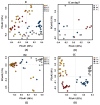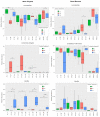Relative Effects of Dietary Administration of a Competitive Exclusion Culture and a Synbiotic Product, Age and Sampling Site on Intestinal Microbiota Maturation in Broiler Chickens
- PMID: 34564581
- PMCID: PMC8472864
- DOI: 10.3390/vetsci8090187
Relative Effects of Dietary Administration of a Competitive Exclusion Culture and a Synbiotic Product, Age and Sampling Site on Intestinal Microbiota Maturation in Broiler Chickens
Abstract
In this research, the effects of early post-hatch inoculation of a competitive exclusion product (Br) and the continuous feeding of a synbiotic supplement (Sy) containing probiotic bacteria, yeast, and inulin on the production traits and composition of ileal chymus (IC), ileal mucosa (IM), and caecal chymus (CC) microbiota of broiler chickens were evaluated. The dietary treatments had no significant effects on the pattern of intestinal microbiota or production traits. The digestive tract bacteriota composition was affected mostly by the sampling place and age of birds. The dominant family of IC was Lactobacillaceae, without change with the age. The abundance of the two other major families, Enterococcaceae and Lachnospiraceae decreased with the age of birds. In the IM, Clostridiaceae was the main family in the first three weeks. Its ratio decreased later and Lactobacillaceae became the dominant family. In the CC, Ruminococcaceae and Lachnospiraceae were the main families with decreasing tendency in the age. In IC, Br treatment decreased the abundance of genus Lactobacillus, and both Br and Sy increased the ratio of Enterococcus at day 7. In all gut segments, a negative correlation was found between the IBD antibody titer levels and the ratio of genus Leuconostoc in the first three weeks, and a positive correlation was found in the case of Bifidobacterium, Rombutsia, and Turicibacter between day 21 and 40.
Keywords: Broilact; IBD antibody titre; caecal chymus; competitive exclusion; gut microbiota development; ileal chymus; ileal mucosa; synbiotic.
Conflict of interest statement
All authors declare no conflict of interest.
Figures







References
-
- Apajalahti J., Kettunen A., Graham H. Characteristics of the gastrointestinal microbial communities, with special reference to the chicken. Worlds. Poult. Sci. J. 2004;60:223–232. doi: 10.1079/WPS20040017. - DOI
-
- Popova T. Effect of probiotics in poultry for improving meat quality. Curr. Opin. Food Sci. 2017;14:72–77. doi: 10.1016/j.cofs.2017.01.008. - DOI
LinkOut - more resources
Full Text Sources

